Milwaukee 2212-20 Handleiding
Milwaukee
Multimeter
2212-20
Bekijk gratis de handleiding van Milwaukee 2212-20 (11 pagina’s), behorend tot de categorie Multimeter. Deze gids werd als nuttig beoordeeld door 67 mensen en kreeg gemiddeld 4.2 sterren uit 34 reviews. Heb je een vraag over Milwaukee 2212-20 of wil je andere gebruikers van dit product iets vragen? Stel een vraag
Pagina 1/11

OPERATOR'S MANUAL
MANUEL de L'UTILISATEUR
MANUAL del OPERADOR
TO REDUCE THE RISK OF INJURY, USER MUST READ AND UNDERSTAND OPERATOR'S
MANUAL.
AFIN DE RÉDUIRE LE RISQUE DE BLESSURES, L'UTILISATEUR DOIT LIRE ET BIEN
COMPRENDRE LE MANUEL DE L'UTILISATEUR.
PARA REDUCIR EL RIESGO DE LESIONES, EL USUARIO DEBE LEER Y ENTENDER EL
MANUAL DEL OPERADOR.
AUTO VOLTAGE/CONTINUITY TESTER AND AUTO VOLTAGE/CONTINUITY
TESTER W/ RESISTANCE
TESTEUR AUTOMATIQUE DE TENSION/CONTINUITÉ ET TESTEUR
AUTOMATIQUE DE TENSION/CONTINUITÉ AVEC RÉSISTANCE
PROBADOR AUTOMÁTICO DE VOLTAJE/CONTINUIDAD Y PROBADOR
AUTOMÁTICO DE VOLTAJE/CONTINUIDAD CON RESISTENCIA
Cat. No.
No de cat.
2212-20
2213-20

23
IMPORTANT SAFETY INSTRUCTIONS
WARNING READ ALL SAFETY WARNINGS AND INSTRUCTIONS. Failure to follow
the warnings and instructions may result in electric shock, fi re and/or serious injury, as well as
instrument damage and/or damage to the equipment being tested. Save these instructions - This
operator’s manual contains important safety and operating instructions for the MILWAUKEE
Electrical Testers. Before using, read this operator’s manual and all labels on the Electrical Testers.
DANGER
Never make measurement on a circuit in which voltage over 600V rms exists. Use only leads
rated 600V CAT IV or better.
Do not apply more than the rated voltage, as marked on the Tester, between terminals or
between any terminal and earth ground.
Do not attempt to make measurement in the presence of fl ammable gases. Otherwise, the use
of the instrument may cause sparking, which can lead to an explosion.
Never attempt to use the instrument if its surface or your hand is wet.
Do not exceed the maximum allowable input of any measuring range.
Only test on unenergized circuits unless absolutely necessary.
Check tool functionality on a known circuit fi rst. Never assume tool is working. Assume circuits
are live until they can be proven de-energized.
Never open the Battery cover during a measurement.
Do not ground yourself while measuring. Avoid body contact with earthed or grounded sur-
faces such as pipes, radiators, ranges and refrigerators.
This instrument is to be used only in its intended applications or conditions. Otherwise, the instru-
ment's safety functions may not work, resulting in serious personal injury and instrument damage.
To reduce the risk of injury from shock and arc blasts, always wear personal protective
equipment where live conductors are exposed.
WARNING
Never attempt to make measurement if any abnormal conditions, such as broken case and
exposed metal parts are found on the instrument.
Comply with local and national safety requirements when working in hazardous locations.
Keep fi ngers behind the guards and away from test lead tips during measurements.
Do not change the slide switch position (Cat. No. 2213-20) while the test leads are being con-
nected.
Verify proper operation on a known source before use or taking action as a result of the in-
dication of the instrument.
Do not install substitute parts or make any modifi cation to the instrument. For repair, return
the tool to a factory Service/Sales Support Branch or authorized service station.
Do not try to replace the batteries if the surface of the instrument is wet.
Disconnect all the cords and cables from the object under test and power off the instrument
before opening the Battery Cover for Battery replacement.
This tool is designed to be powered by 2- AAA batteries properly inserted in the Milwaukee
Electrical Tester. Do not use with any other voltage or power supply.
Install battery according to polarity (+ and –) diagrams.
Do not leave batteries within the reach of children.
Do not mix new and used batteries. Do not mix brands (or types within brands) of batteries.
Properly dispose of used batteries.
Do not incinerate or dismantle batteries.
Under abusive conditions, liquid may be ejected from the battery, avoid contact. If contact
accidentally occurs, fl ush with water. If liquid contacts eyes, additionally seek medical help.
Liquid ejected from the battery may cause irritation or burns.
CAUTION
Set the Slide Switch (Cat. No. 2213-20) to an appropriate position before starting measurement.
Disconnect test leads from test points before changing the slide switch function (Cat. No.
2213-20).
Never connect to a source of voltage with the tester OFF or slide switch position in Ω (Cat.
No. 2213-20).
Firmly insert the test leads.
Do not expose the instrument to the direct sun, high temperature and humidity or dew fall.
Altitude 2000m or less. Appropriate operating temperature is within 0ºC and 50ºC.
Keep away from excess dust and water.
Be sure to power off the instrument after use. When the instrument will not be in use for a long
period, place it in storage after removing the batteries.
Use a damp cloth or neutral detergent for cleaning the instrument. Do not use abrasives or
solvents.
GENERAL SPECIFICATIONS
Maximum voltage between
any terminal and earth ground
600V CAT IV
Temperature Operating: 0°C to 50°C (32°F to 122°F)
Storage: -10°C to 60 °C (-14°F to 140°F)
Operating Altitude 2,000 m
Drop Test 1 m
Battery 2 AAA, NEDA 24 A,IEC LR03
Battery Life Approx. 20 Hours normal use
Safety Compliances UL/CSA/IEC/EN 61010-1 3rd Edition and IEC/EN 61010-2-033 1st
Edition (Meter), UL/CSA/IEC/EN 61010-031 1st Ed + A1 (Probes).
Measurement Category IV, 600V, Pollution Degree II,
EMC EN 61326-1.
Certifi cations cULus, CE
Function Range Resolution Accuracy †
Voltage AC 5 - 600 V 1 V ±(3.0% + 5 dgt)
Voltage DC 2 - 199.9 V 0.1 V ±(3.0% + 5 dgt)
200 - 600 V 1 V ±(3.0% + 5 dgt)
Resistance 2 - 20 k 0.01 k ±(3.0% + 5 dgt)
Continuity Continuity Buzzer
0 - 20 k
Continuity Buzzer sounds
at 20 k or less
FUNCTIONS
† Accuracy specified as ±(% of reading + 5 digits)
* Input impedance AC/DC Voltage : 300 k
* Overload protection:
For 2212-20 - Meter protected for inputs above rated voltage AC/DC 600 V
For 2213-20 - Function Switch at , Meter protected for inputs above rated voltage AC/DC 600 V
Function Switch at , Meter protected for inputs above rated voltage AC/DC 420 V
* Test leads rated for 10A with: measurement time 30 seconds maximum, rest time 20 minutes minimum,
40°C ambient.

45
Loading/Changing the Batteries
Replace batteries when the Low Battery indicator
is displayed.
1. Press the Power ON/OFF button to turn off the
tester. Disconnect the test leads.
2. Unscrew and
remove battery
door.
3. Insert two (2)
AAA batteries,
according to the
polarity marked
in the battery
compartment
4. Close the battery
door and tighten
two (2) screws
securely.
Installing/Removing the Belt Clip
The belt clip can be removed/installed into the
accessory bay. Line up the belt clip and secure
with the accessory bay screw.
Storage
To store the leadwires when not in
use, rotate the belt clip 90°. Wrap
the leadwires around the body of the
tester. Rotate the belt clip down to
hold the leadwires in place.
Probe Tip Sleeves
Measurement Category and Voltage Rating of the
Test Leads:
Probe Tip Sleeves ON: Cat IV, 600V / CAT III 1000V
Probe Tip Sleeves OFF: Cat II 1000V
To remove the probe tip sleeves:
1. Disconnect the test leads from the tester.
2. Grasp the probe fi rmly in one hand.
3. Hold the probe tip sleeve fi rmly with the other
hand.
4. Pull to remove the probe tip sleeve to expose
more of the probe tip.
5. Push probe tip sleeve back onto probe tip when
not in use.
SYMBOLOGY
Read Operator’s Manual
Double insulation
Earth
Danger, Warning, or Caution
- Consult the operators
manual for additional safety
information.
Risk of electrical shock - To
avoid electric shock, remove
test leads before opening bat-
tery door
Battery compartment
European Conformity Mark
Underwriters Laboratories, Inc.,
United States and Canada
Cat IV Classifi cation of transient
overvoltages, based on
nominal line voltage to earth.
Do not dispose of this product
as unsorted municipal waste.
ASSEMBLY
WARNING To avoid an electrical
hazard, turn the tester OFF and disconnect the
test leads before replacing batteries.
OPERATION
LCD Backlight
The LCD backlight will turn off about 20 seconds
after Power-ON is pressed. The backlight will be
triggered on every time a voltage is measured
higher than 5 V AC/DC. It will not reactivate under
resistance or continuity measurements.
LED Worklight
Press the Worklight Button to turn the LED on and
off. The worklight will turn off automatically after
about 1 minute. It is not necessary to turn on the
Tester to use the worklight.
Making a Measurement
Auto-Function
The tester is designed to auto range at all times.
With Auto Ranging, the tool will automatically select
the range with the best resolution
The Tester automatically switches from Voltage AC/
DC measurement to Continuity when no voltage
is present. The tool will automatically identify VAC
from VDC and will indicate which on the display.
Hazard Voltage Warning
If measured voltage is over AC/DC 35 V, the
Indicator LED will be lit RED and the buzzer will
sound with steady, intermittent beeps (B_B_B).
Over-Range Indication
If measured voltage exceeds the measuring range
(over approximately 600V), the and Indicator
LEDs fl ash rapidly, alternating RED and YELLOW.
The buzzer will sound with bursts of three repeating
beeps (BBB_BBB_BBB).
Auto Off Function
The tester is automatically powered off in about
10 minutes after Power-ON is pressed, preceded
by two beeps. To continue use, press the Power-
ON again after shut-off. If the display is still blank,
replace the batteries.
WARNING Only use test Milwaukee
leads with the MILWAUKEE Tester. Inspect
test leads for continuity before each use. Do
not use if the readings are high or noisy.
FUNCTIONAL DESCRIPTION
1. Display
2. Worklight button
3. Power button
4. Function switch
(Cat.No. 2213 only)
5. Terminal inputCOM
6. Ω Terminal input
7. Indicator
8. LED Worklight
9. Indicator
10. Probe storage
11. Grips
12. Accessory bay
5 6
8
9 7
10
12
11
4
2
1
3
Product specificaties
| Merk: | Milwaukee |
| Categorie: | Multimeter |
| Model: | 2212-20 |
Heb je hulp nodig?
Als je hulp nodig hebt met Milwaukee 2212-20 stel dan hieronder een vraag en andere gebruikers zullen je antwoorden
Handleiding Multimeter Milwaukee

20 Juni 2023

2 Mei 2023

28 Februari 2023

22 Februari 2023

8 Februari 2023

6 Februari 2023

22 Januari 2023

6 December 2022

24 Oktober 2022

14 Oktober 2022
Handleiding Multimeter
- Kyoritsu
- Tacklife
- Somogyi
- Cablexpert
- Yato
- Testo
- Metrel
- Schneider
- Monacor
- Brennenstuhl
- Stanley
- REV
- Elro
- GW Instek
- Benning
Nieuwste handleidingen voor Multimeter
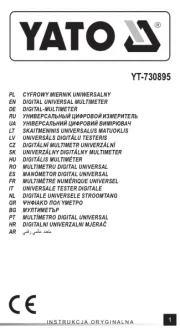
15 Juli 2025
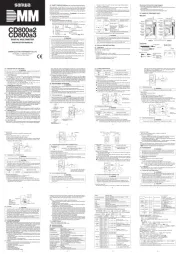
22 Juni 2025
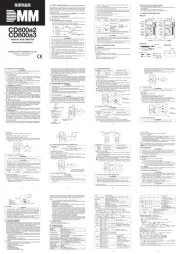
22 Juni 2025
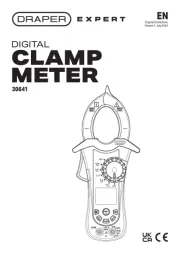
7 Juni 2025
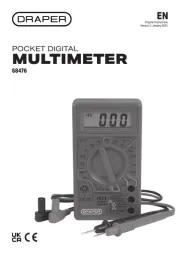
4 Juni 2025
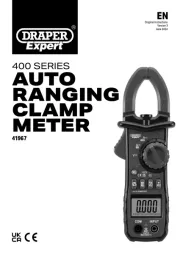
3 Juni 2025
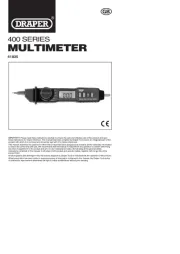
2 Juni 2025
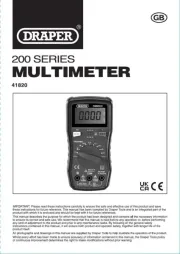
30 Mei 2025
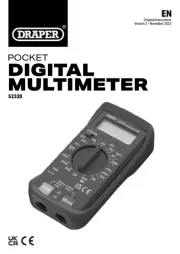
30 Mei 2025
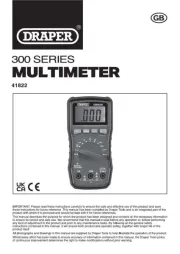
30 Mei 2025